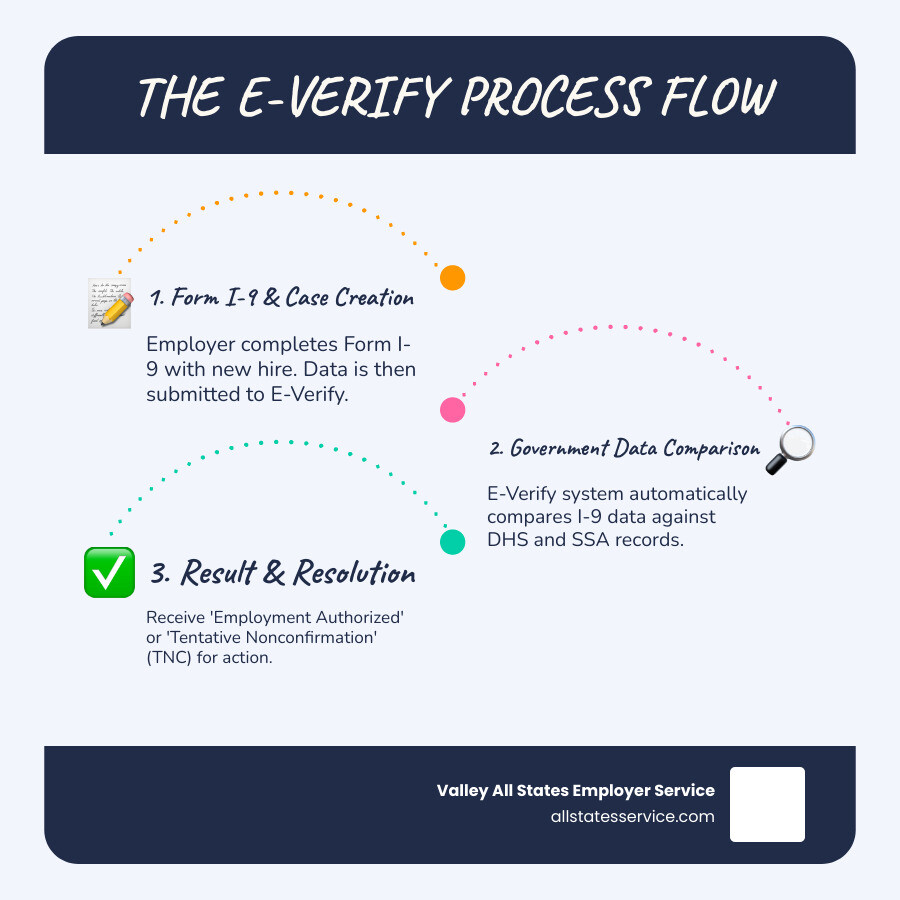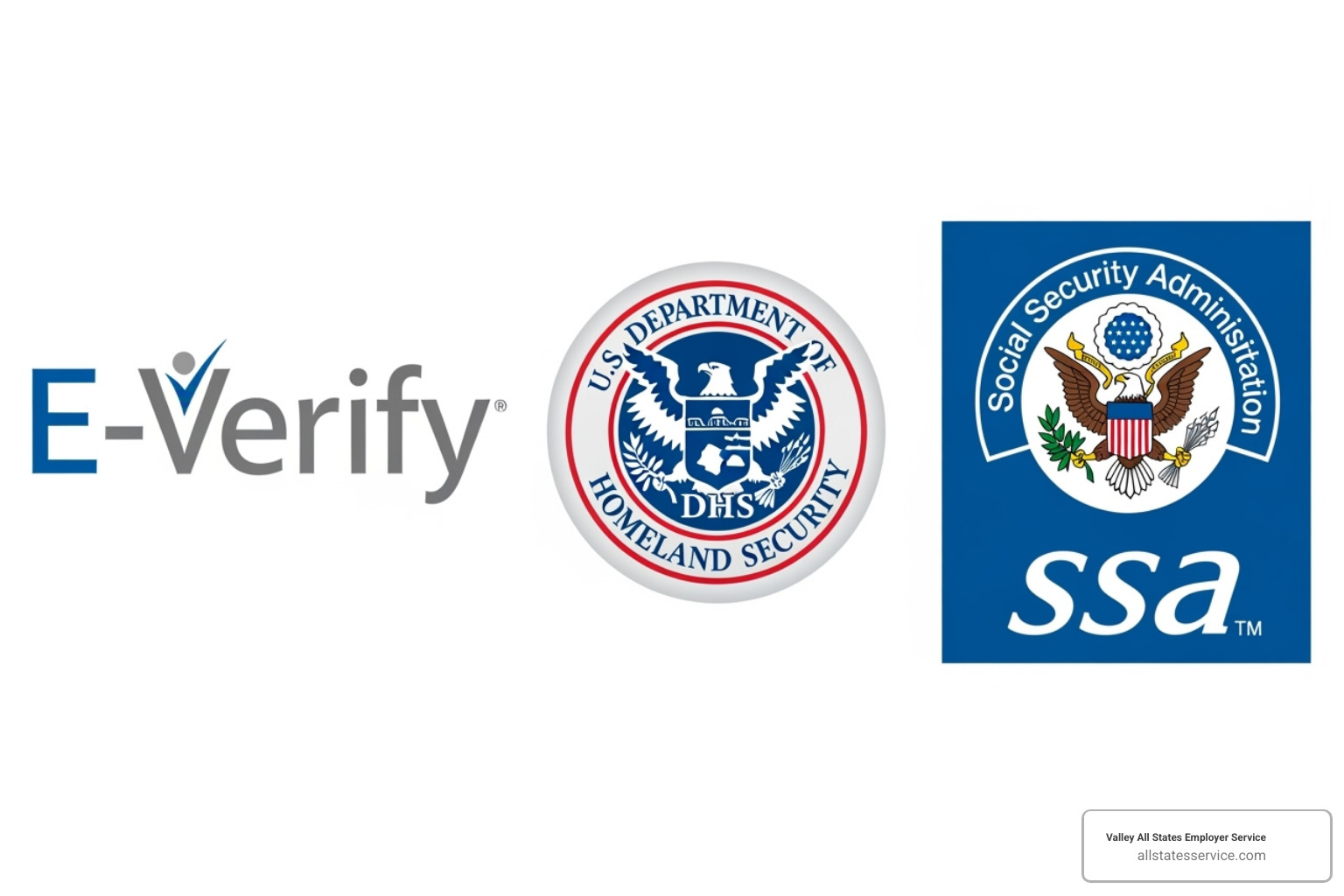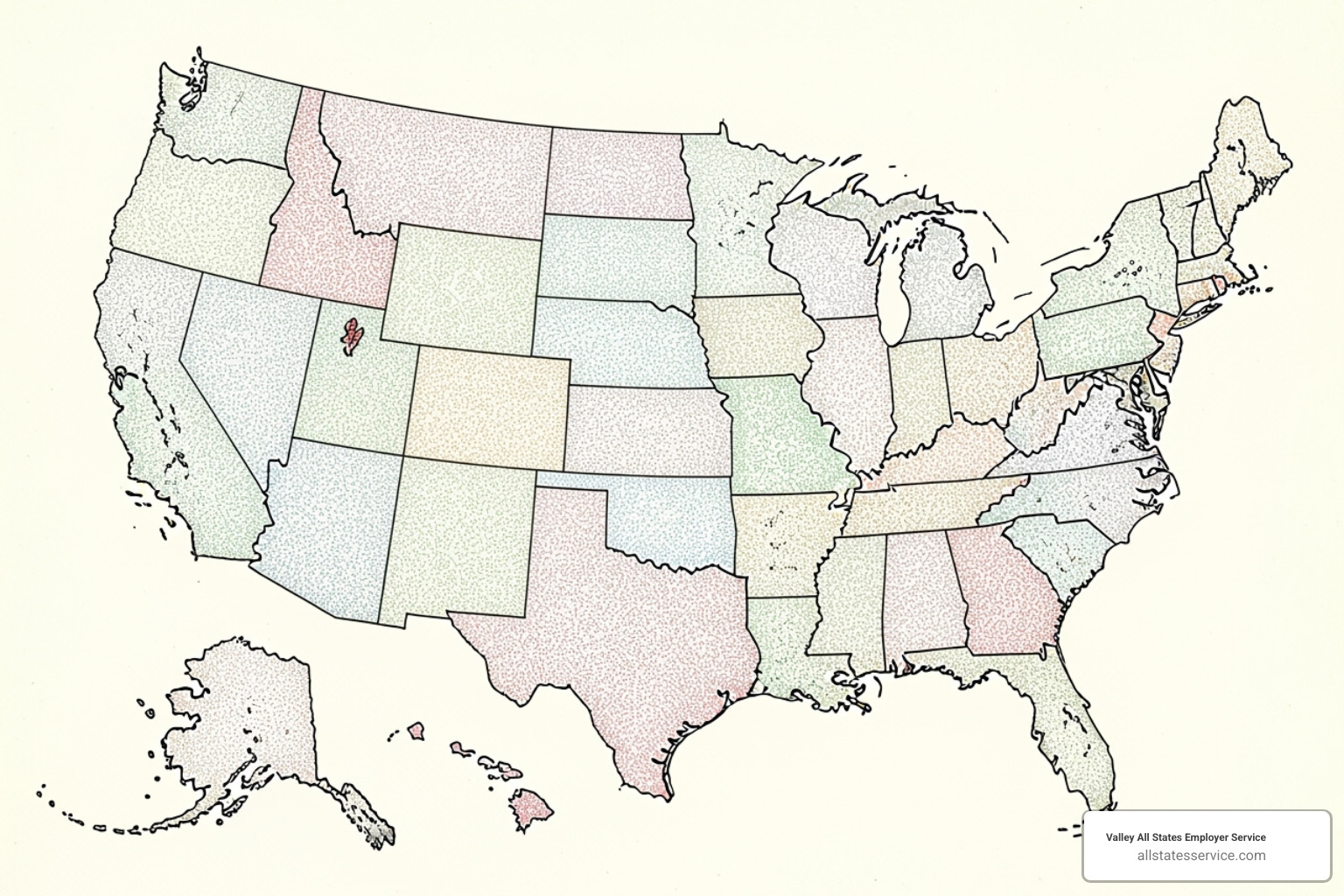E-Verify workforce solutions: Master Compliance 2025!
Why E-Verify Workforce Solutions Are Essential for Modern Businesses
E-Verify workforce solutions help employers confirm workers are legally authorized to work in the U.S. This internet-based system, run by DHS and SSA, checks employee information against government records, delivering results in 3-5 seconds for nearly 1 million employers. It’s a free or low-cost way to build a legal workforce and prevent identity fraud.
Employment eligibility verification is complex, with changing state laws and digital tools. However, E-Verify can simplify your hiring process.
The system uses Form I-9 data to instantly confirm work authorization, building confidence in your hiring. This guide covers everything from setup to advanced features like E-Verify+ and remote hiring, whether you’re using it voluntarily or by mandate.

What is E-Verify and How Does It Work?
E-Verify workforce solutions confirm if your new hires are legally authorized to work in the United States. This internet-based system, a partnership between the U.S. Department of Homeland Security (DHS) and the Social Security Administration (SSA), provides confidence in your hiring decisions.
By comparing employee information against government records, it delivers results in 3 to 5 seconds. Nearly 1 million employers at over 2.4 million hiring sites trust this system because it works.
Want to explore the fundamentals? Check out our detailed explanation of What is E-Verify? and learn how it functions as a comprehensive E-Verify Verification System.

The E-Verify Process Step-by-Step
The beauty of E-Verify lies in its simple four-step process.
Step 1: Complete Form I-9. Within three business days of their start date, the new employee completes their section, and you examine their documents and complete yours.
Step 2: Create E-Verify Case. You enter the employee’s information from Form I-9 into the E-Verify system, including name, date of birth, and Social Security Number.
Step 3: System Compares Information. E-Verify instantly checks the submitted data against SSA and DHS records to confirm identity and work authorization.
Step 4: Receive Result. Within seconds, you receive a result: either Employment Authorized or a Tentative Nonconfirmation (TNC), which indicates a discrepancy.
For a deeper dive into how this fits with your onboarding, explore our guide on the E-Verify Onboarding Process.
Understanding E-Verify Case Results
Knowing what to do with each case result is crucial for compliance.
Employment Authorized: This is the most common result. The employee’s information matched government records. Record the case number on their Form I-9, and you are done.
Tentative Nonconfirmation (TNC): This indicates a mismatch, often due to a typo or a name change. You must notify the employee with a “Further Action Notice” and cannot take adverse action based on the TNC alone.
Referral Date Confirmation: If an employee contests a TNC, you provide this confirmation. It gives them eight federal government working days to contact the appropriate agency.
Final Nonconfirmation: This occurs if an employee doesn’t contest a TNC or the issue isn’t resolved. It means the employee is not authorized to work, and you must end their employment.
Cases may also be placed in continuance if an agency needs more time. The employee continues to work. After a final result, you close the case in E-Verify.
Learn more about tracking your E-Verify Case Status or join a free E-Verify Overview webinar to get hands-on training.
The Core Benefits of Integrating E-Verify Workforce Solutions
Integrating E-Verify workforce solutions turns a complex paperwork process into a streamlined, reliable one, giving you confidence that your team is legally authorized to work.

Key benefits include:
- Legal Workforce Assurance: Protect your business from fines, legal issues, and reputational damage by ensuring compliance.
- Identity Fraud Prevention: The system helps stop the use of stolen documents, protecting your business and honest job seekers.
- Good-Faith Defense: Proper use of E-Verify can shield you from certain penalties if an unauthorized worker is hired inadvertently.
- Efficiency and Accuracy: E-Verify reduces paperwork and errors by cross-referencing information with government records, leading to faster processing.
For a deeper dive into these advantages, check out the comprehensive Benefits of E-Verify and learn how it strengthens your E-Verify I-9 Compliance strategy.
How E-Verify Integrates with Form I-9
A common misconception is that E-Verify replaces Form I-9, but it does not. The two systems work together. Form I-9 is the foundational document every new hire must complete.
E-Verify then takes the information from the completed Form I-9 and electronically compares it against government databases for confirmation.
Your recordkeeping requirements expand slightly, as you must record the E-Verify case number on the employee’s Form I-9 or file the case details with it, creating a clear audit trail. Learn more about managing this relationship through our guide on E-Verify and I-9 integration.
Combating Fraud and Ensuring a Legal Workforce
E-Verify’s features spot fraud that is nearly impossible to detect visually. The photo matching tool compares the photo on an employee’s document (like a Permanent Resident Card) with the image in government databases, preventing the use of counterfeit documents.
Social Security Number verification immediately flags discrepancies with SSA records, catching both fraud and honest mistakes. E-Verify also acts as a deterrent for unauthorized workers, who are less likely to apply when they know their eligibility will be electronically checked.
This protects jobs for legal workers and creates a more trustworthy workforce. These fraud-fighting capabilities make E-Verify an essential part of E-Verify Background Checks and modern hiring.
Navigating Advanced Features and Recent Updates
The employment verification landscape is constantly evolving, with updates that make managing E-Verify workforce solutions smoother, especially for remote and hybrid teams.

New features like E-Verify+ and myE-Verify streamline workflows and empower employees. Recent changes to Form I-9 procedures have also been a game-changer for remote hiring. You can learn more by checking out the new Form I-9 announcement.
Streamlining Onboarding with E-Verify+
E-Verify+ is the next generation of employment verification, combining Form I-9 completion and E-Verify submission into a single integrated digital process. Its employee self-service feature allows new hires to submit their Form I-9 information from any device, reducing data entry errors.
Modernized for hybrid work, it ensures a consistent, compliant process for all employees, regardless of location, while still delivering instant results. While E-Verify+ is not yet available through employer agents, we are monitoring its development. Learn more at More on E-Verify+.
Empowering Employees with myE-Verify
myE-Verify empowers employees with tools to manage their own verification. The Self Check feature allows individuals to confirm their eligibility status and correct discrepancies before the hiring process begins, reducing the chance of a TNC.
For security, the Self Lock feature lets employees lock their Social Security Number for free to prevent misuse. Employees also get case history access for full transparency. We recommend sharing myE-Verify for your workers with your teams to ensure a smoother process.
The New Era of Remote Hiring and Form I-9
Recent updates have simplified remote hiring compliance. The new one-page Form I-9, mandatory since November 2023, is streamlined and easier to complete.
The biggest breakthrough is remote document examination for employers enrolled in E-Verify. You can now examine I-9 documents remotely, a process that includes a live video interaction requirement to maintain integrity.
These changes have revolutionized hiring for distributed workforces but require careful attention to detail. For more, see our E-Verify Remote Hiring Complete Guide.
Staying Compliant: State Laws, Policy Changes, and Best Practices
E-Verify compliance is not a one-time task. Rules change, state laws vary, and new policies emerge frequently, making it a challenge to manage E-Verify workforce solutions, especially across multiple locations.

What is required in one state may differ from another, and federal updates can shift the landscape overnight. Understanding E-Verify Employer Requirements is essential to protect your business from costly mistakes.
Understanding State-Specific E-Verify Requirements
While E-Verify is federally voluntary for most private employers, states have their own rules. This creates a complex web of requirements.
- Mandatory vs. Voluntary States: Some states mandate E-Verify for all employers, while others require it only for public employers or state contractors. A few even restrict its use.
- Public and Private Distinctions: Government agencies and state/federal contractors often face mandatory E-Verify use, even when private businesses in the same state do not.
- Non-Compliance Penalties: Penalties vary by state and can range from fines to suspended business licenses or even criminal charges.
Our E-Verify State Laws Complete Guide breaks down the requirements, and What Employers Are Required to Use E-Verify? helps you determine where your business stands.
Adapting to Policy Changes and E-Verify Workforce Solutions
Immigration policy shifts directly impact E-Verify processes, so staying current with guidance from DHS and USCIS is critical. For example, Temporary Protected Status (TPS) updates, like those affecting Venezuela, require close attention to EAD expiration dates and reverification procedures.
Similarly, special guidance for Afghan and Ukrainian parolees defines their work eligibility based on specific documents. To help manage these changes, E-Verify introduced a new Status Change reporting tool that acts as an early warning system for issues like parole terminations.
Following E-Verify Best Practices means staying informed about these regular policy shifts to protect your business.
The Role of E-Verify Employer Agents
Managing E-Verify workforce solutions is complex, with varying state laws, policy updates, and strict deadlines. Many businesses feel overwhelmed.
E-Verify Employer Agents act as compliance partners, handling these details so you can focus on your business. As a USCIS-authorized third-party administrator, we manage your E-Verify processes from start to finish, giving you the benefits of compliance without the administrative headache. This is especially valuable for businesses with limited HR resources.

Learn more about becoming an E-Verify Employer Agent or how our services can transform your compliance approach.
How an Employer Agent Can Help Your Business
Working with an employer agent means you send us new hire information, and we handle the rest. Here’s how we help:
- Case Management: We handle E-Verify cases from creation to completion, including guiding you through any TNC resolutions.
- Form I-9 Review: Our experts review Form I-9s for errors and provide electronic forms with smart technology to prevent mistakes.
- Timely Submission: We ensure cases are submitted within the three-business-day deadline, with most processing completed in under 24 hours.
- Expert Guidance: Our team monitors immigration rule changes and provides up-to-date advice on best practices and state requirements.
- Cost-Effectiveness: Our services, starting as low as $10 per employee, are often more affordable than managing compliance in-house.
We are authorized to verify workforces in all 50 states. Explore our E-Verify Outsourcing solutions or see how we support E-Verify for Small Businesses.
Choosing the Right Partner for Your E-Verify Workforce Solutions
Choosing the right partner for your E-Verify workforce solutions is crucial. Look for these key qualities:
- Expertise and Authorization: Ensure the agent is authorized by USCIS and has deep knowledge of E-Verify, Form I-9, and relevant laws.
- Comprehensive Service: A great partner offers more than basic submission, including Form I-9 review, electronic solutions, and TNC resolution support.
- Responsive Customer Support: You need a partner who provides prompt, clear guidance when questions or urgent issues arise.
- Transparent Pricing: Look for a clear cost structure without hidden fees to help you budget effectively.
A strong partnership provides confidence that experts are protecting your business. See our approach to E-Verify Employer Customer Service for an example of exceptional support.
Frequently Asked Questions about E-Verify
Employers often have questions about how E-Verify fits into their hiring process. Here are answers to the most common questions about E-Verify workforce solutions.
Does E-Verify replace the Form I-9?
No, E-Verify does not replace the Form I-9. They are partners. Every U.S. employer must complete a Form I-9 for every new hire. This is the foundational document for verifying identity and work authorization. E-Verify is a separate, subsequent step that electronically confirms the information from the Form I-9 against government databases. For participating employers, both are required.
Can I use E-Verify for existing employees?
Generally, no, E-Verify is for new hires only. It is not for verifying your existing workforce. However, there are exceptions. Federal contractors with the FAR E-Verify clause may be required to verify existing employees working on federal contracts. You may also need to interact with the system to resolve a TNC for a current employee that was initiated when they were hired. For more details on these exceptions, see our guide on E-Verify for Existing Employees.
What happens if an employee gets a Tentative Nonconfirmation (TNC)?
A TNC is not a final result; it simply indicates a mismatch in records that needs resolution. Common causes include typos or name changes.
Your legal obligations are to provide the employee with the official Further Action Notice from E-Verify and allow them to continue working. You cannot take any adverse action, such as termination or reduced hours, based on a TNC. The employee has the right to contest it.
The employee has eight federal government working days to decide. If they contest, you provide a Referral Date Confirmation, and they work with the appropriate agency to resolve the issue. You will only receive a Final Nonconfirmation, which requires you to end employment, if the employee does not contest or cannot resolve the issue.
Simplify Your Compliance with Expert E-Verify Services
Ensuring every new hire is legally authorized to work is critical, but E-Verify compliance is complex. The system involves Form I-9 integration, evolving policies, varying state laws, and specific procedures for TNCs and remote hiring. These challenges can overwhelm any employer.
E-Verify workforce solutions are simple with the right partner. As your authorized E-Verify Employer Agent, Valley All States Employer Service takes this burden off your shoulders. We handle the entire process, ensuring every case is processed correctly and on time.
Our team manages all rule changes, policy updates, and state-specific requirements. We review Form I-9s for errors, manage E-Verify cases, and provide expert guidance, allowing you to focus on your business. Our efficient approach minimizes errors and administrative work across all 50 states.
Ready to transform your hiring process from a compliance headache into a smooth, confident operation?